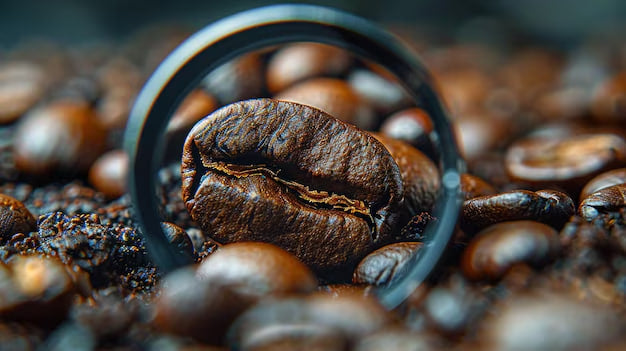The world of coffee is rich with intricate details, from the origin of the bean to the nuances of brewing. Among the many factors that contribute to the final cup, the size of the coffee bean might seem like a straightforward element. However, the dimensions of these seemingly simple seeds hold a surprising level of influence over various aspects of the coffee experience.
A common question among both novice and seasoned coffee drinkers is whether the size of the bean truly impacts the quality and taste of their brew. This report aims to delve into the complexities of coffee bean size, exploring its definition, measurement, and the ways in which it affects roasting, grinding, flavor, and the final cup of coffee.
Understanding the Brix Coffee: Definition, Importance, and Benefits
What Is Coffee Bean Size, and Why Does It Matter?
Coffee bean size refers to the physical dimensions of a coffee bean, usually measured in millimeters or inches. It is a key grading criterion, influencing the consistency of roasting, flavor extraction, and even market price. Larger beans are often associated with higher quality, though this isn’t always the case. Understanding bean size helps in selecting the right coffee for your brewing method and flavor preferences.
Coffee Grades: A Comprehensive Guide to Understanding Coffee Quality
How Is Coffee Bean Size Measured?
Screen Size Method-How Coffee Is Sorted By Size?
The term "coffee bean" technically refers to the roasted seed of the coffee cherry, a fruit produced by coffee plants. While all coffee beans share this fundamental origin, they exhibit a remarkable degree of variation in their physical dimensions. This seemingly simple characteristic, size, can encompass various aspects, including the length and width of the bean, and even its density, all of which can have implications for the subsequent stages of coffee preparation. On average, a coffee bean measures approximately 10 millimeters in length and 6 millimeters in width, offering a baseline for understanding the typical scale involved.

The primary method for quantifying and classifying coffee bean size within the industry involves a process known as screen sizing. This technique utilizes a series of screens, or sieves, each containing precisely sized, round holes. The diameter of these holes is measured in increments of 1/64th of an inch. For instance, a screen size of 18 indicates that the holes are 18/64th of an inch in diameter.
Coffee beans are passed through a stack of these screens, starting with the largest holes at the top and progressing to the smallest at the bottom. This sifting process allows for the sorting of beans based on their ability to pass through specific screen sizes, effectively categorizing them by dimension. The typical range of screen sizes employed in the coffee trade generally spans from size 8 (8/64th of an inch) to size 20 (20/64th of an inch), encompassing a spectrum of bean dimensions. While this system provides a standardized method for measuring bean size, it is important to note that the relationship between size and overall coffee quality is not always direct.
Beyond the numerical precision of screen sizing, various regions and coffee-producing countries employ their own descriptive terms to classify coffee bean size. These terms, while often indicative of a general size range, can vary significantly, potentially causing confusion for consumers. For example, in Central America and Mexico, larger beans might be labeled as "Superior," while in Colombia, the term "Supremo" denotes a larger bean size, and "Excelso" refers to beans that are slightly smaller.
Similarly, in Africa and India, the grading term "AA" often signifies a larger bean size. The following table illustrates some of these regional variations in terminology in relation to standard screen sizes, providing a reference point for understanding these different classifications.
|
Screen Size (64ths of an inch) |
Classification (Central America & Mexico) |
Classification (Colombia) |
Classification (Africa & India) |
|
20 |
Superior |
Supremo |
AA |
|
19.5 |
Superior |
Supremo |
AA |
|
19 |
Superior |
Supremo |
AA |
|
18.5 |
Superior |
Supremo |
AA |
|
18 |
Superior |
A |
|
|
17 |
Superior |
Excelso |
A |
|
16 |
Segundas |
Excelso |
B |
|
15 |
Segundas |
Excelso |
B |
|
14 |
Terceras |
C |
|
|
13 |
Caracol |
Caracol |
PB |
|
12 |
Caracol |
Caracol |
PB |
|
11 |
Caracolli |
Caracolli |
PB |
|
10 |
Caracolli |
Caracolli |
PB |
|
9 |
Caracolillo |
Caracolillo |
PB |
|
8 |
Caracolillo |
Caracolillo |
PB |
The Impact of Size: How Bean Dimensions Influence Your Coffee

The size of a coffee bean, while not the sole determinant of quality, exerts influence on several critical stages of coffee preparation, from roasting to brewing. One of the most significant impacts of bean size is observed during the roasting process. Coffee beans of varying sizes absorb heat at different rates.
Larger beans, possessing a greater mass, typically require more time and heat to roast evenly throughout, whereas smaller beans roast more quickly. This difference in roasting dynamics underscores the importance of sorting beans by size prior to roasting. Roasting a batch of unsorted beans can lead to inconsistencies, with smaller beans potentially becoming over-roasted or burnt while larger beans remain under-developed in the center.
Therefore, roasters often prioritize uniform bean size to ensure a balanced and optimally developed flavor profile in their final roasted product.
While the fineness of the grind is primarily determined by the coffee grinder itself, the initial size of the coffee bean can indirectly affect the consistency of the resulting coffee grounds. Larger, denser beans might yield a more uniform grind particle size compared to smaller, less dense beans, although this is not always the case and depends heavily on the quality and calibration of the grinder.
Furthermore, the desired grind size for various brewing methods often correlates with a general bean size tendency. For instance, coarser grinds, typically preferred for brewing methods like the French press and cold brew, are often more readily achievable with larger beans. Conversely, finer grinds, essential for espresso, might be associated with smaller bean sizes, though again, the grinder is the primary determinant.
A common belief is that larger coffee beans inherently possess a superior flavor profile. However, the relationship between bean size and the resulting taste and aroma is more nuanced than a simple correlation.
While larger beans might have benefited from a longer maturation period on the coffee plant, allowing for more complex flavor development, the ultimate taste is more significantly influenced by a confluence of factors, including the specific botanical variety, the geographical origin and its terroir, the processing methods employed, and the skill of the roaster. There are notable exceptions to the "bigger is better" notion.
Types of Common Coffee Bags? Dimension Chart of Size Coffee Bags
Peaberry beans, for example, are smaller, rounder beans that develop when only one seed forms inside the coffee cherry instead of the usual two. These smaller beans are often prized for their concentrated and sometimes sweeter flavors. Conversely, "Elephant beans," which are exceptionally large, can sometimes present challenges in achieving an even roast due to their size.
Different coffee bean sizes can also be indirectly linked to various brewing methods through the recommended grind size. While the grind size is the primary factor dictating the extraction process, there's a general tendency for certain bean sizes to be more suitable for achieving specific grind textures.
For instance, larger beans might be preferred for coarser grinds needed for French press and cold brew, as they tend to break down into more consistent, larger particles. Smaller beans, on the other hand, might be more easily ground to the fine consistency required for espresso brewing. However, it is crucial to reiterate that the grinder's capabilities and settings are the most critical determinants of the final grind size, regardless of the initial bean size.
Navigating the Grading Maze: Understanding Size Classifications
Screen size serves as a fundamental criterion in the grading and classification of green coffee beans within the coffee industry. As previously described, beans are sorted based on their ability to pass through screens with specific hole diameters. This process aims to ensure a degree of uniformity in bean size within a particular lot, which is crucial for achieving consistent roasting.
While the target screen size for a coffee lot is specific, a small percentage of beans that fall slightly outside this range is often permitted. The screen sizing system provides a common language for communicating about the physical dimensions of coffee beans, which can be associated with certain expectations regarding quality and potential flavor characteristics, although these associations are not always definitive.
Adding to the complexity, various coffee-growing regions have developed their own unique grading terminologies that often incorporate bean size as a key factor. In Colombia, for instance, the terms "Supremo" and "Excelso" are widely used to denote bean size, with Supremo beans being larger (typically passing through a screen size of 18) and Excelso beans being slightly smaller (usually passing through a screen size of 16).
Kenyan coffee employs a more intricate system, with "AA" signifying relatively large beans (passing through screen sizes 17 and 18), "AB" indicating slightly smaller beans (screen sizes 15 and 16), and "PB" denoting the unique Peaberry beans. The term "E," or Elephant bean, is used for the largest Kenyan coffee beans. In Central America and Mexico, classifications like "Superior," "Segundas," and "Terceras" are used, generally corresponding to large, medium, and small bean sizes, respectively.
Brazil's grading system, while also considering bean size (indicated by "SC" for screen size, such as SC 14/16), primarily focuses on the number of defects found in a sample. Understanding these regional variations is crucial for interpreting coffee labels and appreciating the diverse ways in which bean size is considered within the global coffee trade.

Beyond the standard grading systems, certain coffee bean varieties are known for their naturally occurring unusual sizes. Maragogype beans, often referred to as "Elephant beans" in some contexts (though distinct from the Kenyan E grade), are renowned for being among the largest coffee beans in the world, sometimes growing up to 30-40% larger than typical Arabica beans.
Conversely, Mokka beans, originating from Yemen, are known for being exceptionally small. The case of Peaberries further illustrates the complexities of size and quality. These single, smaller, round beans, formed due to a natural mutation within the coffee cherry, are often highly sought after for their unique flavor profiles, demonstrating that smaller size does not necessarily equate to lower quality. These unique instances highlight that while size is a factor considered in coffee grading, other inherent characteristics of the bean play a significant role in the overall coffee experience.
What Determines the Size of a Coffee Bean? Nature and Nurture
The ultimate size of a coffee bean is a result of a complex interplay between the genetic makeup of the coffee plant and the environmental conditions under which it is grown. The botanical variety of the coffee plant is the most significant determinant of the inherent size potential of its beans. For example, Arabica coffee beans, which constitute the majority of global production, are typically larger and more elongated compared to Robusta beans.
Within the Arabica family, specific cultivars like Maragogype are genetically predisposed to producing exceptionally large beans, while others, like Mokka, naturally yield much smaller seeds. Liberica coffee beans are known for their large and often irregular shape, setting them apart from both Arabica and Robusta. Excelsa beans, considered a variety within the Liberica species, are smaller than typical Liberica but still larger than most Arabica and Robusta beans, often exhibiting a distinctive teardrop shape.
The genetic blueprint of the coffee plant, therefore, lays the foundation for the potential size and shape of its beans.
While genetics establishes the inherent potential, the environmental conditions during the coffee plant's growth and the development of the coffee cherry play a crucial role in influencing the final size of the bean. Altitude is a significant factor, with coffee grown at higher elevations often producing larger and denser beans. The cooler temperatures at higher altitudes slow down the maturation process of the coffee cherry, allowing more time for the bean to develop and absorb nutrients from the soil.
Adequate rainfall is also essential for proper bean development, with sufficient water availability during the rapid growth phase (typically 2-5 months after flowering) contributing to larger bean sizes. Conversely, insufficient rainfall can lead to stressed plants and the production of smaller beans. Temperature and soil quality also play a role, influencing the overall health and productivity of the coffee plant and, consequently, the size and quality of its beans.
While less direct, the processing methods employed after harvesting the coffee cherries can also have a subtle impact on the final size and density of the green coffee beans. Different processing techniques, such as the washed, natural (dry), and honey processes, affect the moisture content and overall structure of the bean, which can in turn influence its dimensions.
For instance, the washed process, which involves removing the fruit pulp before drying the beans, might result in slightly different bean characteristics compared to the natural process, where the entire cherry is dried with the bean inside.

Frequently Asked Questions (FAQ) about Coffee Bean Size
FAQ 1: Does the size of a coffee bean affect its caffeine content?
- Generally, the caffeine content in coffee is more closely linked to the variety of the bean than its size. Robusta beans are known to have significantly higher caffeine levels compared to Arabica beans, regardless of the specific size within those varieties.
FAQ 2: Should I choose coffee beans based on their size?
- While bean size can sometimes be an indicator of potential quality, particularly in terms of uniformity for roasting, it is more advisable to focus on other factors such as the bean variety, its origin, the processing method used, and your personal flavor preferences.
FAQ 3: What is the "screen size" I see on some coffee bags?
- The term "screen size" refers to the diameter of the holes in the screens used to sort green coffee beans by size. This measurement is expressed in 64ths of an inch and is a common way to grade and classify bean dimensions within the coffee industry.
FAQ 4: Do different roast levels affect the size of the coffee bean?
-
Yes, the roasting process causes coffee beans to expand as they lose moisture. It is estimated that beans can increase in size by approximately 50% during roasting. However, this expansion is generally proportional across different starting bean sizes.
Conclusion
In conclusion, the size of a coffee bean is a multifaceted characteristic that plays a role in various stages of the coffee journey, from cultivation and processing to roasting and brewing. While the screen sizing system provides a standardized method for measurement and grading, and regional terminologies offer further classifications, the relationship between bean size and the ultimate quality and flavor of the coffee is not always straightforward.
Genetic variety and environmental growing conditions are the primary determinants of a bean's inherent size, while factors like roasting and brewing methods are influenced by size, often indirectly through grind consistency.




